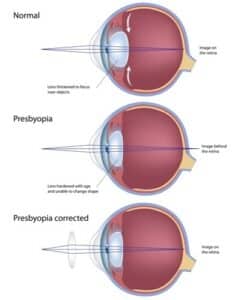Make Readers a Thing of the Past After Refractive Lens Exchange
- Posted on: Nov 10 2022
Are you tired of wearing reading glasses whenever you need to see something up close? Nearly everyone will need to rely on readers at some point in their life, though it’s most common in their forties or fifties.
As you age, your eyes lose their ability to focus on nearby objects due to decreasing elasticity of their natural lens. When this occurs, it’s called presbyopia, age-related farsightedness, or dysfunctional lens syndrome.
The good news is that you don’t have to resort to readers if you’re dealing with the stresses of presbyopia. Keep reading to discover how you can make readers a thing of the past after having a procedure called refractive lens exchange!
What Is Refractive Lens Exchange?
Refractive lens exchange (RLE) is a vision correction procedure similar to cataract surgery. The only difference is that when a patient has refractive lens exchange, it is not to remove a cataract.
Instead, it’s intended to eliminate or reduce the need for visual aids while ensuring that the patient doesn’t need to worry about cataracts later in life.
RLE can treat nearsightedness, farsightedness, astigmatism, and presbyopia. It is typically performed in patients who are fifty and older and struggling with the symptoms of presbyopia.
The procedure works by removing the eye’s natural lens and replacing it with an artificial lens. The artificial lens, an intraocular lens (IOL), contains the necessary lens power to see clearly.
This differs from LASIK and similar vision correction procedures that instead reshape the cornea. Instead of reshaping the cornea, RLE replaces the natural lens to improve your vision.
RLE is an outpatient procedure, meaning you can go home the same day you’ve undergone it. On the day of your procedure, you’ll receive a calming medication and a local anesthetic to ensure you are relaxed and don’t feel a thing.
It takes about fifteen minutes per eye to perform refractive lens exchange. The recovery time is also quick, and most people can return to normal activities the next day.
You can expect to begin to see better by the following day. Your vision will only continue to improve as your eyes heal and recover.
Some patients even notice a change in their vision immediately following the procedure. Each patient is different, so it may take a day or two before you see changes to your vision.
What Types of IOLs Are There?
When it comes to intraocular lenses, you have what can feel like endless choices. Intraocular lenses are permanently implanted lenses that take over the job of your natural lens.
You will use them to look at the world around you for the rest of your life, and because of that, which IOL you choose to have implanted during refractive lens exchange is a big decision. Choosing the IOL that’s best for you and your lifestyle goals is essential.
At Jacksonville Eye Center, we are proud to offer various premium lens options. These lenses provide clear vision at all distances: near, far, and intermediate.
A premium lens significantly differs from standard lenses that only allow you to see clearly at one distance. Standard IOLs, or monofocal lenses, mean you have to wear glasses if you want to see at distances other than the one you had corrected.
Patients with a standard monofocal lens still need to wear glasses regularly. They may be able to see distant objects clearly, but nearby objects are still blurry.
This is because you can only choose one distance to have them focus on. On the other hand, premium lenses can reduce or even eliminate the need for visual aids, as you can see multiple distances.
They are sometimes called “lifestyle lens implants” because they support your ideal lifestyle. When people talk about leaving glasses behind with an intraocular lens, they are referring to this type of lens.
The premium lenses we offer include the Tecnis® Symfony, Tecnis® Multifocal, Toric, and the Multifocal/Restor. If you want to avoid the need for reading glasses, the Tecnis® Symfony can be an excellent choice. These lenses were designed explicitly for presbyopia. We will be happy to discuss your lens options at your consultation.
Why Should You Choose RLE Instead of Readers?
Reading glasses temporarily fix a problem that will only worsen with time. As you age, the lens of your eye becomes stiffer, meaning it cannot change shape as well as it should to perceive close-up objects. RLE is the permanent solution you’ve been looking for!
Those who usually wear readers know how frustrating it can be to rely on glasses to see anything up close. It’s easy to lose or damage them.
Plus, it’s a waste of your precious time to look for them or buy new ones. Refractive lens exchange is the far more convenient choice.
After the procedure, most patients can significantly reduce their dependence on readers if they need them. This means you can see objects near and far when you wake up. It also makes the transition between distances seamless.
Another benefit of refractive lens exchange is that you won’t have to worry about developing a cataract in the future. Cataracts are so common that they affect more than 24 million Americans.
When you have an IOL, it’s impossible to get a cataract later in life. That means your new, clearer vision will be here to stay, and you won’t have to undergo cataract surgery in the future.
You can look forward to decades of crystal clear vision after refractive lens exchange and no longer having to deal with the symptoms of dysfunctional lens syndrome. What could be better than that?
Are you ready to make readers a thing of the past? Today, schedule your RLE consultation at Jacksonville Eye Center in Jacksonville, FL!
Posted in: news



